
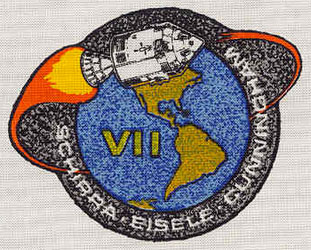
|
|


| Crew & Mission |
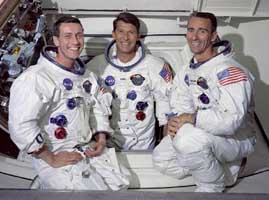 The Apollo-7 crew;Walter M. "Wally" Schirra Jr., Donn F. Eisele, and F. Walter Cunningham.
The Apollo-7 crew;Walter M. "Wally" Schirra Jr., Donn F. Eisele, and F. Walter Cunningham. The primary objectives for Apollo 7 were simple: "Demonstrate CSM/crew performance; demonstrate crew/space vehicle mission support facilities performance during a manned CSM mission; demonstrate CSM rendezvous capability." The first manned Apollo flight speed skyward from Launch Complex 34 a few minutes after 11:00 on the morning of 11 October. (Saturn IB 205 and CSM-101, the first Block II CSM) Ten and a half minutes after launch Apollo 7 reached the first stage of its journey, an orbital path 227 by 285 kilometers above the earth. Some of the crew's grumpiness during the mission could be attributed to physical discomfort. About 15 hours into the flight, Schirra developed a bad cold, and Cunningham and Eisele soon followed suit. Several days before the mission ended, they began to worry about wearing their suit helmets during reentry, which would prevent them from blowing their noses. The buildup of pressure might burst their eardrums. Slayton, in mission control, tried to persuade them to wear the helmets, anyway, but Schirra was adamant. They each took a decongestant pill about an hour before reentry and made it through the acceleration zone without any problems with their ears. That "magnificent flying machine," as Cunningham called it, circled the earth for more than 260 hours. On 22 October, the crew brought the ship down in the Atlantic southeast of Bermuda, less than two kilometers from the planned impact point. On landing, the craft turned nose down, but the crew quickly inflated the air bags and the ship righted itself. The tired, but happy, voyagers were picked up by helicopter and deposited on the deck of the U.S.S. Essex.
|
| A Personal Story |
|
..."The Apollo-7 design itself highlighted the Earth orbital nature of the Mission. it was our original intention to emphasize the first manned Apollo (Gus Grissom's flight) and the recovery from the fire on the pad aspects as well. We considered depicting a spacecraft rising from a ball of fire and calling it the Phoenix. The patch designed was subject to NASA approval and we abandoned the Phoenix theme feeling it would be rejected as in bad taste. I zeroed in on a circle (for the Earth) and an ellips (for orbit). The orbital plane was tilted for artistic reasons..."
|
| The Artwork |
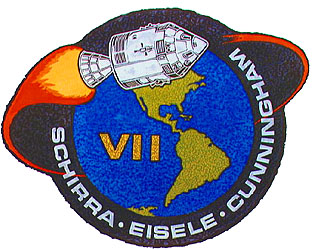 (June, 1968) -- NASA photo ID: S68-26668. APOLLO 7 INSIGNIA: The official emblem of Apollo 7, the first manned Apollo spacemission.
|
| The Real Thing |
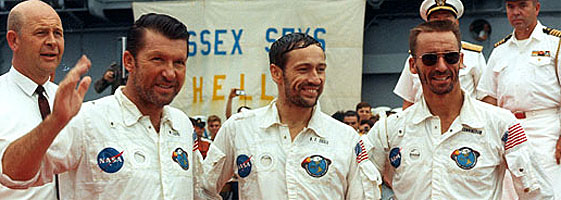 The crew wearing the beta-cloth patch on their intravehicular suits. 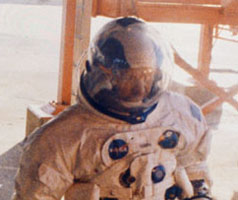 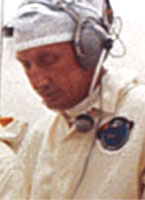 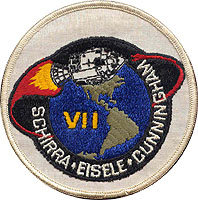 Left: Schirra wearing the beta-cloth patch on his suit during launchday. Center: A suittech wearing an embroidered patch in a white circle. Right: Close-up of the patch.  The crew wearing the same embroidered mission patch, without the white circle. It is similar to the one shown at the top of this page. The manufacturer is unknown. |
| Variations |
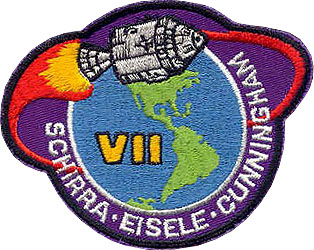 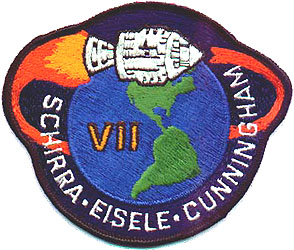 Left: One of the two Lion Brothers versions - this one has a purple background. A blue background also exists. Right: The AB-Emblem version. |